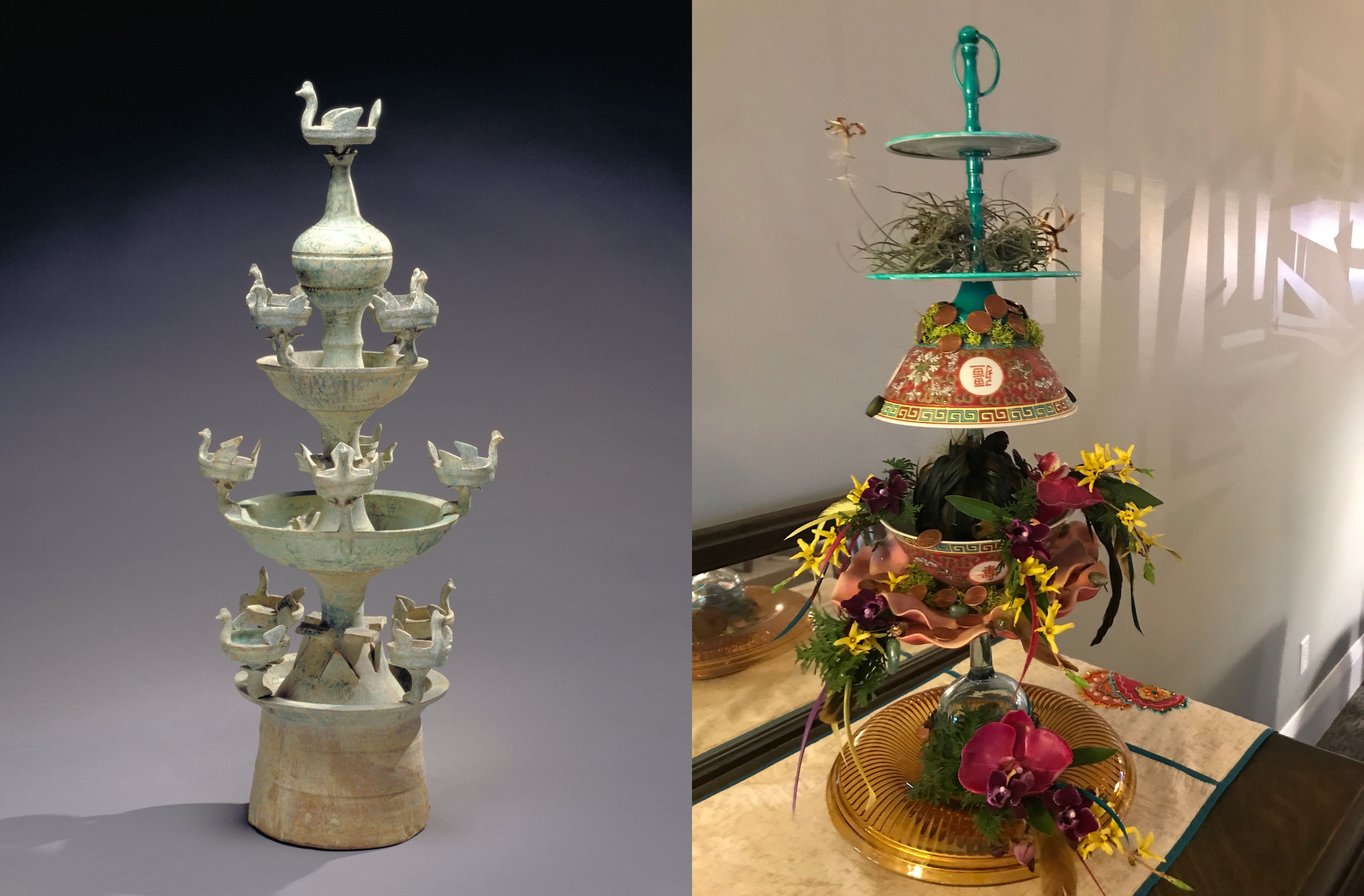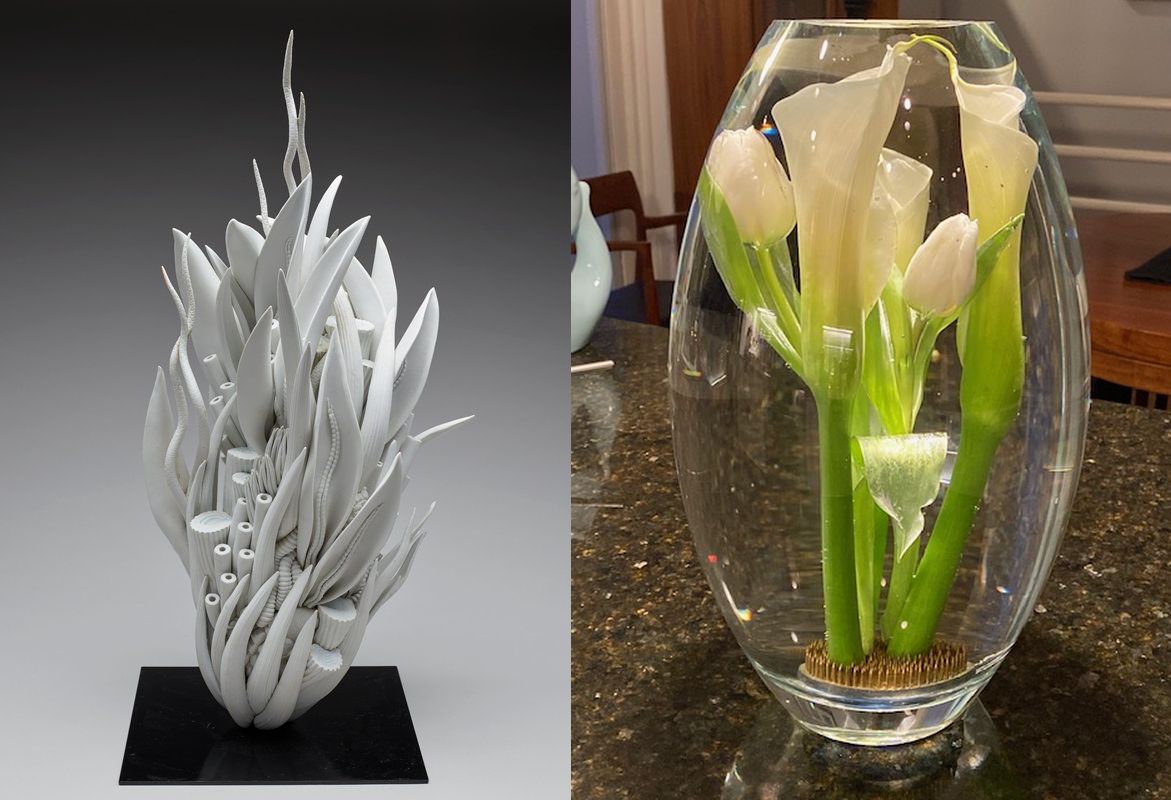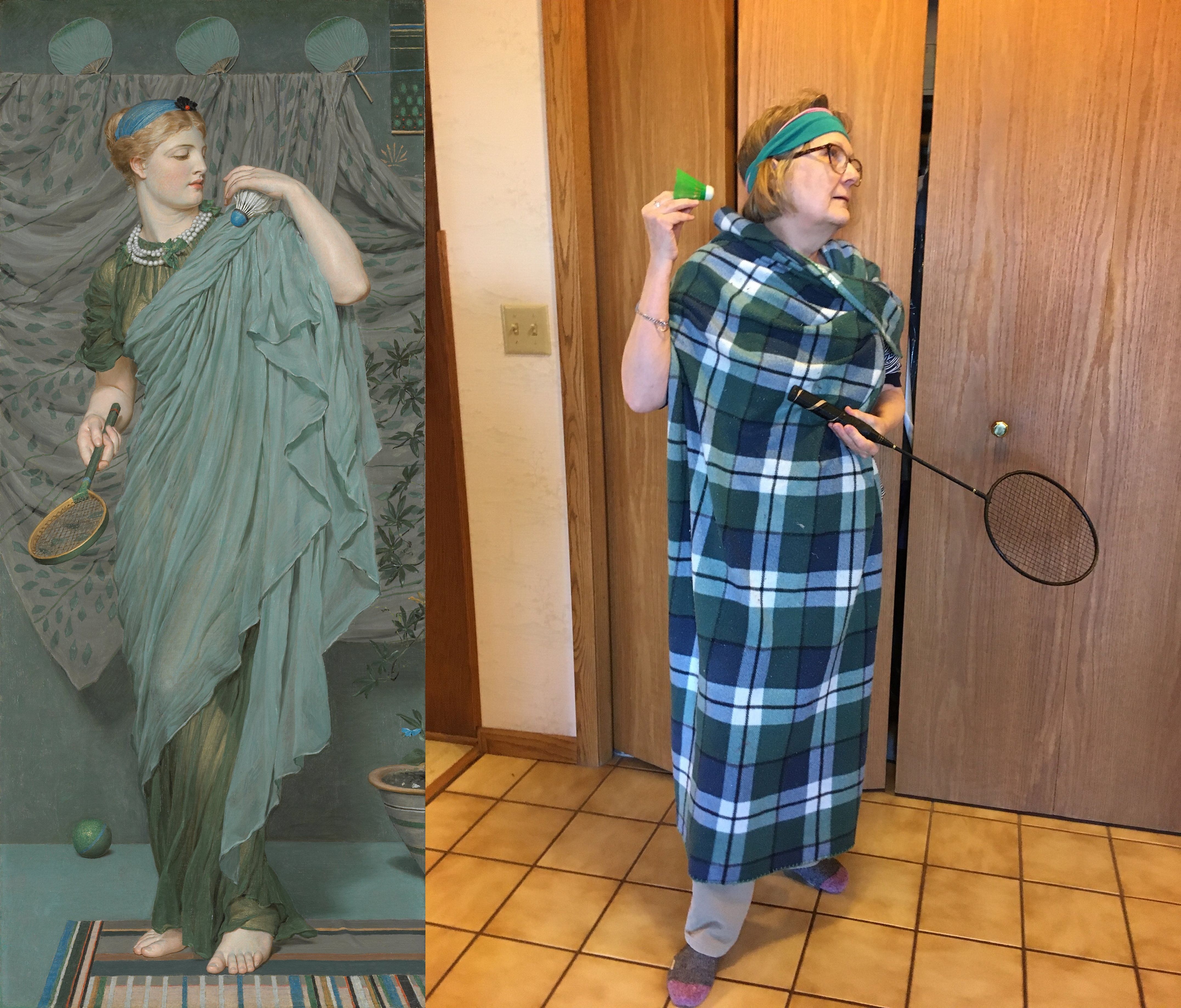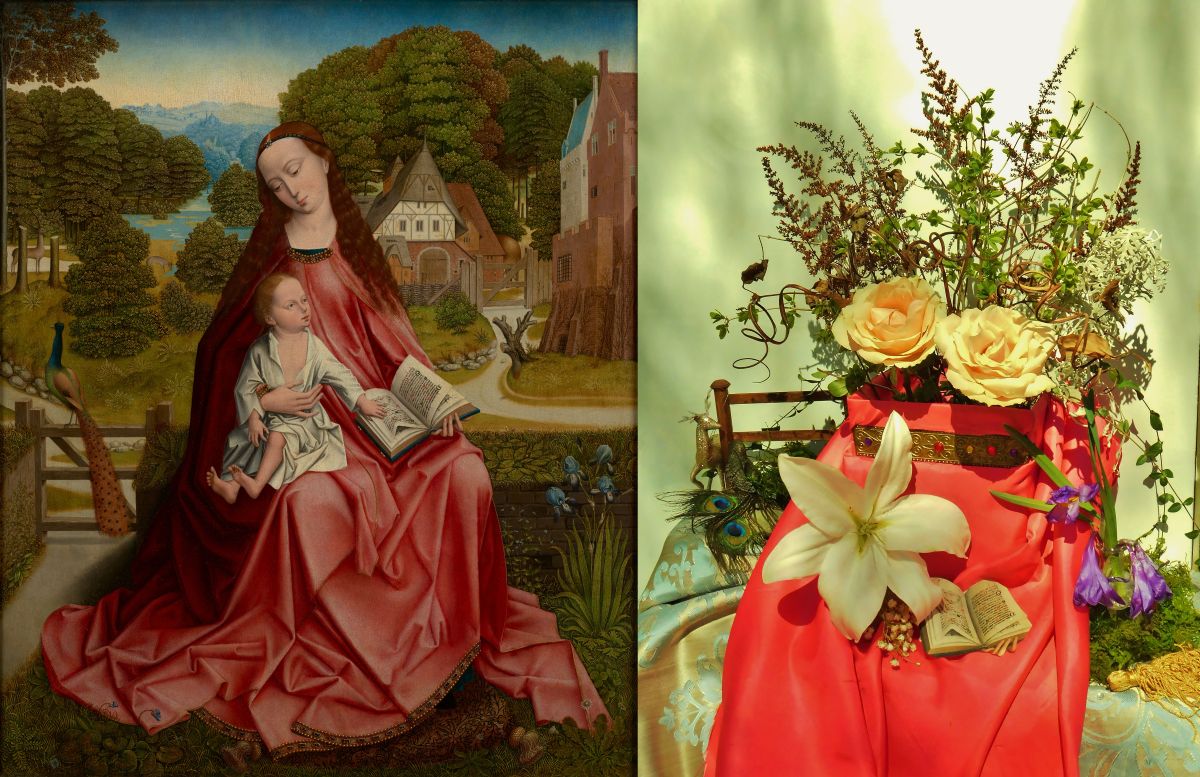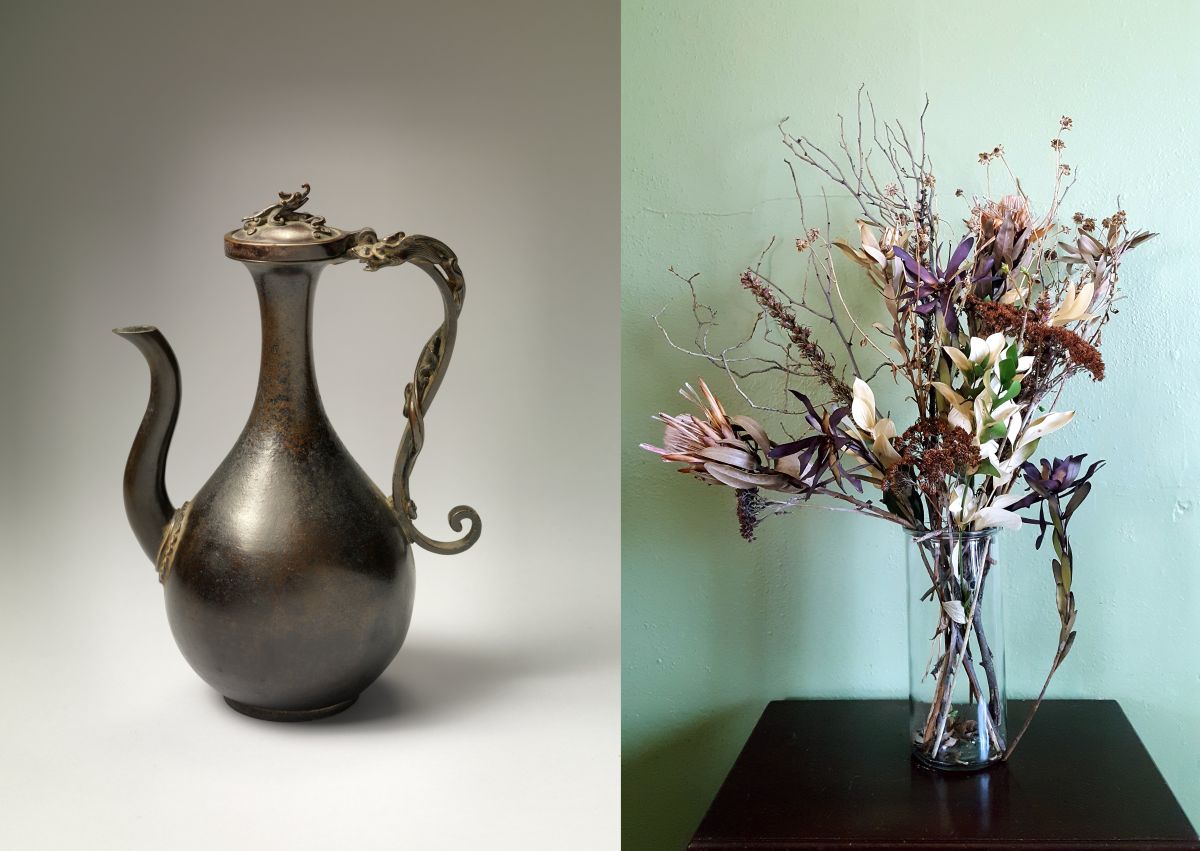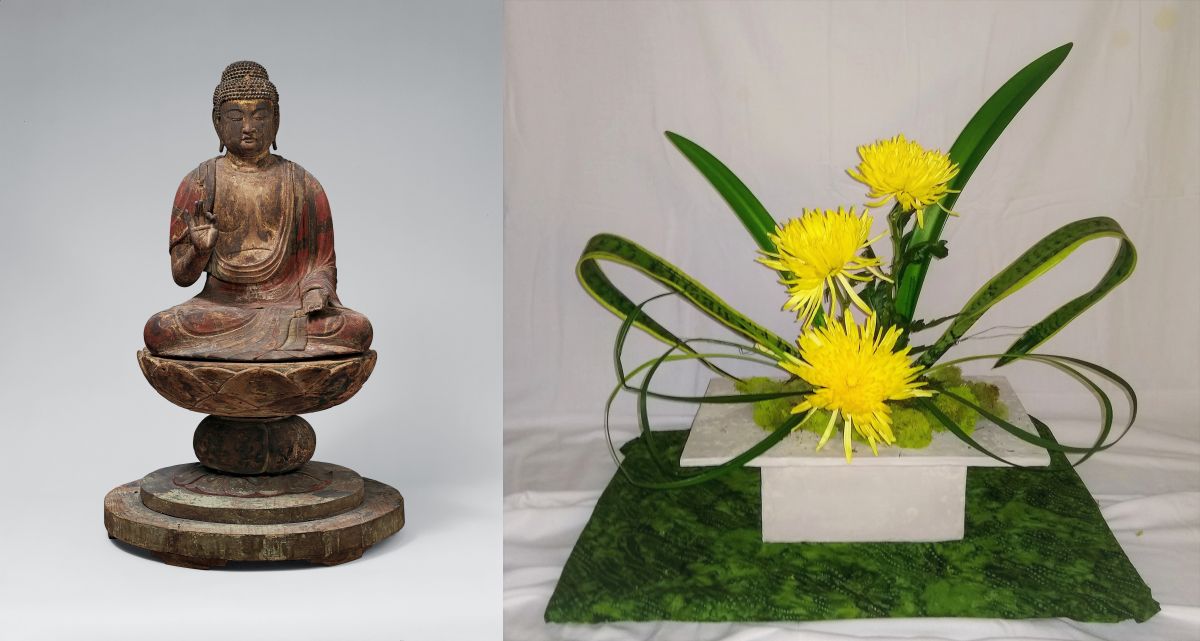
Art in Bloom, from Home
Art and Bloom,
From Home
April 23-26, 2020!
Pedestal Floral Artists Creations
-
“I chose the pottery lamp because I like what it signifies: A soul’s safe journey into the next life! My piece is an assortment of old dishes given to me by my family and friends, each one carries a special meaning and memory. This sculpture is a way for me to give renewed life to these pieces.” – Colleen Mikesh
Pictured: (Left) China, Asia, “Pottery Lamp”, 1st century, Earthenware with green glaze. Gift of Wayne and Rosalee MacFarlane, 99.68a-c; (Right) Interpretation by Colleen Mikesh
-
“Inspired by my love for travel and the beauty of Venice, Italy, I selected The Piazza San Marco, for my floral interpretation. The sun reflecting off the gold cathedral in combination with the blue birds’ movements create a peaceful scene.” – Stefani Tygar Barnes
Pictured: (Left) Pierre Auguste Renoir (France, 1841–1919), “The Piazza San Marco,” “The Piazza San Marco,” Venice, 1881, Oil on canvas. The John R. Van Derlip Fund, 51.19; (Right) Interpretation by Stefani Tygar Barnes
-
“This photo is a first draft of the idea I wanted to use for AIB. I was drawn to this amazing sculpture by its unique beauty; inspiring this “haiku” Pale silent motion, Leaves unfurl in light filled waves, Floating into space.
I hope to represent this dynamic tension and balance in my arrangement.
I wanted to create an “anti-gravity” feel for the arrangement by filling the container to the very top with water…so the flowers and leaves would float. I started with these calla lilies and tulips to also keep a monochromatic presentation. I don’t know if these would have been the flowers for Art in Bloom in April, but it was the start I had in February. I also would have found a way to surround the kenzan with other materials.” – Noni Threinen
-
“The black cone of grapevine provides the base for this floral design with the dark calla lilies and bear grass creating movement and the feeling of a spinning tornado. Ranunculus, scabiosa, leucadendron, and hypericum all represent the darkness of the twister, a fluffy white hydrangea is the only element sprayed black to represent the dark cloud.” – Karen Ortiz, Lakeville Hy-vee
Pictured: (Left) Julius Holm (United States, 1855–1930), “Tornado over St. Paul,” 1893, Oil on canvas. The Ethel Morrison Van Derlip Fund, 77.28; (Right) Interpretation by Karen Ortiz, Lakeville Hy-vee
-
“I wanted to use tall and short bear grass to show the different levels to give the visual of the lion crouching. I used Pampas grass for the mane to give it that texture feel.” – Dennis M Kelner
Pictured: (Left) Ancient Greek (Greece, Europe) “Crouching Lion,” 330–317 BCE, Pentellic marble. The Ethel Morrison Van Derlip Fund, 25.25; (Right) Interpretation by Dennis M Kelner
-
“Elevated to art through seemingly simplistic form, elegant imagery and detailing. Evoking the power and subtlety of nature. What was its journey to this moment? Who wore this? Who made this Shirt? Who is the unnamed artist?” – Artis Curiskis and Sara Weiner
Pictured: (Left) Fulani (Nigeria, Africa), “Man’s shepherd shirt,” Cotton. Gift of Joanne B. Eicher, 2013.78.4; (Right) Interpretation by Artis Curiskis and Sara Weiner
-
“The warm feeling that “Sunburst” evokes is exactly what inspired the floral arrangement my parents and I decided to create. The beautifully delicate characteristics of the yellow flowers mirror the fragility of the suspended glass arrangement.” – Esther Stoy, John Stoy, and Suzanne Stoy
Pictured: (Left) Dale Chihuly, (United States, 1941), “Sunburst,” 1999, Blown glass, neon, metal armature. Gift of funds from Donna and Cargill MacMillan Jr., 99.132, © 2019 Chihuly Studios / Artists Rights Society (ARS), New York https://collections.artsmia.org/art/31146/sunburst-dale-chihuly; (Right) Interpretation by Esther Stoy, John Stoy, and Suzanne Stoy
-
“A slightly masculine featured woman with a delicate pinky? That is American realism. This arrangement cherishes the first American painter Copley’s expertise in capturing texture details in the oil portrait of the colonial noblewoman Sarah Allen.” – Namrata Damle
Pictured: (Left) John Singleton Copley (United States, 1738–1815), “Portrait of Sarah Allen, née Sargent,” 1763, Oil on canvas. The William Hood Dunwoody Fund, 41.3; (Right) Interpretation by Namrata Damle
-
“‘Love and compassion’ This is the inspiration from the meditation I did on the Bodhisattva Avalokiteshvara, so my interpretation was made with the intention to create a floral piece that conveys love and compassion, the feelings and impressions of those powerful emotions. The colors (green and pink also represent the heart chakra) which is why I decided on those colors for the piece. May your heart feel it” – Katie Lee McGuire
Pictured: (Left) Unknown (China, Asia), “Seated Avalokiteshvara Bodhisattva (Guanyin),” 11th–early 12th century, Wood, gesso, mineral pigments, and gold. Gift of Ruth and Bruce Dayton, 98.62a-h; (Right) Interpretation by Katie Lee McGuire
-
Pictured: (Left) Albert Joseph Moore (England, 1841–93) “Battledore”, 1868–70, Oil on canvas. The Christina N. and Swan J. Turnblad Memorial Fund, by exchange, 2003.145 (Right) Interpretation by Debra Kammerer
-
“Since the flowers I had chosen were not available from my providers, I decided to create an abstract wire sculpture creation of pincushion proteas, craspedia, and a ti leaf.” – Amy Kubas
Materials: 17 Gauge Fencing Wire, Spray Paint, Ceramic Vase.
Pictured: Charles-Henri-Joseph Cordier, France, 1827–1905), “The Algerian,” 1850–57, Silvered bronze, algerian jasper, porphyry. The William Hood Dunwoody Fund, 76.3; (Right) Interpretation by Amy Kubas
-
“Each Art in Bloom I select an artwork different from all those that have inspired me in the past. For my 15th year, I was drawn to the texture, depth and movement in this Japanese woodblock print.” – Karla Newman
Pictured: (Left) Hagiwara Hideo (Japan, 1913–2007), “Glaukos,” 1965, Woodblock print; ink and color on paper. Gift of Sue Y.S. Kimm and Seymour Grufferman, 2019.78.78, © Hagiwara Hideo; (Right) Interpretation by Karla Newman
-
“We are a mother/daughter duo excited for our first time participating as novice artists. We were still working out details and ideas when everything shut down and we lost access to many floral materials and the fabrics we wanted to utilize. We always knew we wanted the mother to be the actual vessel/container and a white lily to symbolize the child. Christy was an Art Adventure ‘picture person’ presenter for 6 years and Madeline enjoyed the program while in elementary school. We took a more literal representation of the painting as we knew children would enjoy that. ‘What do you see?’- we would always ask. We have chosen a few of the elements from the painting. Although we had to improvise and our piece is not exactly as intended/complete, we hope you enjoy our interpretation.” – Christy and Madeline Campbell
Pictured: (Left) possibly Master of the Madonna Grog; Artist: possibly Aert van den Bossche; Artist: formerly Master of the Embroidered Foliage, (Netherlands, 1480–1500), “Virgin and Child in a Landscape,” 1492–98, Oil on panel. Gift of the Groves Foundation, by exchange, The Miscellaneous Works of Art Purchase Fund, The Paintings Acquisition Fund, The Painting Deaccession Fund, The Putnam Dana McMillan Fund and unrestricted fund balances, 90.7; (Right) Interpretation by Christy and Madeline Campbell
-
“All the floral material is from dried arrangements I had around the house and my garden.” – Jodie Rodne
Pictured: (Left) Rihei (Japan, 15th–16th century) “Ewer,” 15th–16th century, Bronze. Mary Griggs Burke Collection, Gift of the Mary and Jackson Burke Foundation, 2015.79.435; (Right) Interpretation by Jodie Rodne
-
“I was very drawn to the contrast of light and darkness in this painting. With a subject matter of betrayal and pending death, it struck me how much light was present. Perhaps this piece is teaching us to look for the light in the darkness and the hope when all hope seems lost.” – Ann Mekala, Hyssop
Pictured: (Left) Anthony van Dyck (Netherlands, 1599–1641), “The Betrayal of Christ,” 1618–1620, Oil on canvas. The Ethel Morrison Van Derlip Fund, and the John R. Van Derlip Fund, 57.45; (Right) Interpretation by Ann Mekala, Hyssop
-
“As a child Joan Brown dreamed up enticingly exotic fantasy worlds radically different from her bleak, yet materially-comfortable childhood. Ever feisty, her art was a means of self-revelation, full of rich colors, spirited energy and symbolism.” – Susan Hopp
Pictured: Joan Brown (United States, 1938–90), “Portrait of a Girl,” 1971, Enamel and glitter on masonite. The John R. Van Derlip Fund, 2018.21, © The Joan Brown Estate; (Right) Interpretation by Susan Hopp
-
“I foraged materials from the park to make my arrangement. They’re dropping seeds all over my house so I wouldn’t have been able to use them if we were displaying our pieces in the museum. Guess I lucked out!” – Abbie Baldwin
Pictured: (Left) Alexander Wyant, United States, 1836–92), “Autumn in the Adirondacks,” 1872–73, Oil on canvas. The Siri and Bob Marshall Endowment for American Paintings, 2018.23.1; (Right) Interpretation by Abbie Baldwin
-
“With gratitude to Ikebana International, Ichiyo School.” – Amber Tritabaugh
Pictured: (Left) Japan (Asia) “Vase”, 19th century, Cloisonné enamel. Gift of Gary L. Gliem, 2007.107.15; (Right) Interpretation by Amber Tritabaugh
-
“My arrangement is the interpretation of Amida, the Buddha of Infinite Light. There are strong, simple lines – the three Fuji mums represent the Ground, Heart and Crown Chakras. The vase is handmade by Clay Panther Ceramics.” – Becky Haaf
Pictured: (Left) Unknown (Japan, Asia) “Amida, the Buddha of Infinite Light,” 12th century, Japanese cypress with polychrome and gold. Mary Griggs Burke Collection, Gift of the Mary and Jackson Burke Foundation, 2015.79.256a-c; (Right) Interpretation by Becky Haaf
-
“Un hombre del mundo Jose con su manta de muchos colores En el alféizar un jarrón lleno de flores A man of the world Jose with his blanket of many colors On the windowsill a vase full of flowers” –Stefanie Levi, Atzin Dávila Luinenburg, Izel Dávila Luinenburg
Pictured: (Left) Macena Barton, (United States, 1901–86), “Portrait of José Mojica,” 1928, Oil on canvas. The Ray and Carol Bergeson Endowment for Art Acquisition, 2018.69.1, © Macena Barton; (Right) Interpretation by Stefanie Levi, Atzin Dávila Luinenburg, and Izel Dávila Luinenburg
-
“Despite the rough nature usually ascribed to fauns, this Dancing Faun is full of strength and grace. My floral design conveys this contrast by combining the strong graceful lines of a palm boot with the rough yet impressive king protea.” – Kathryn Malody
Pictured: (Left) Graeco-Roman (Italy / Greece, Europe), “Torso of a Dancing Faun,” 1st century, Marble. The Putnam Dana McMillan Fund, 70.39; (Right) Interpretation by Kathryn Malody
-
“Madame is in the process of her morning toilette having her hair arranged with blue ribbons in the fashionable “fontange” hairstyle. Son Leonor arrives for his morning “bonjour” to Maman but will quickly be hustled to his nursery. On the other hand, the dog is no trouble at all.” – Nadine Ronning, Kirsten Ingerson, and Mary Bona
Pictured: (Left) Nicolas de Largillière (France, 1656–1746), “
Art in Bloom 2020 Supporters
Art in Bloom 2020 Supporters


